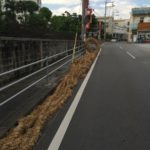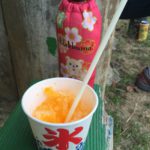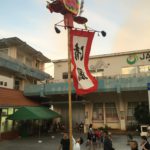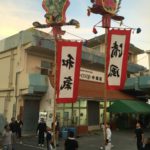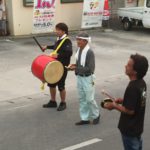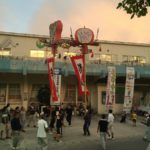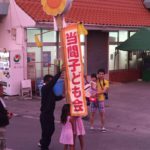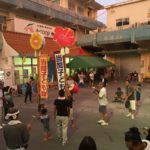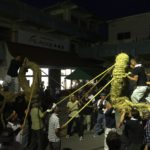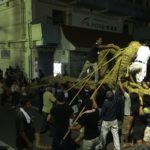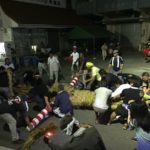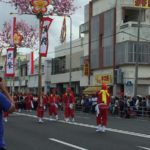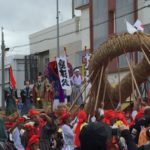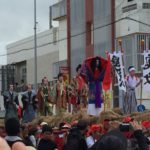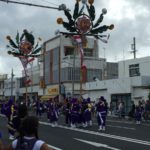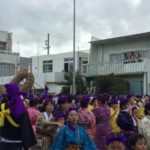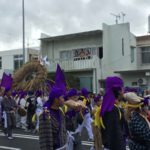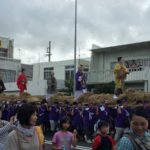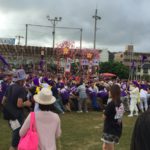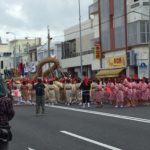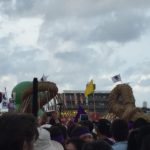Every year in my neighborhood after Obon, near the village office a Tug-of-war 綱引き (tsunahiki) is held. The idea is similar to the larger Tug-of-Wars held in Naha, Itoman, and Yonabaru, except on an obviously much smaller scale. The name of the event in this town is called Marujina マールジナ.
The village starts makes the two ends of the rope, and sets up a small area with free shave ice and drinks (including beer). Around 6 pm, everyone starts to assemble, and eisa music plays on the loudspeakers (which no joke, are definitely left over sound equipment from the 60s, crackly speakers and all). We were lucky this year with no rain– the previous 2 years festivities were cut short due to rain.
We dressed in jinbei 甚平, although almost no one except the very small children dress up for this event, because I feel that I might as well enjoy it properly. So wearing my jinbei, I grabbed a tenugui (towel), uchiwa (fan), and a beer, and walked down the street to the event. Of course, being foreigners we stick out, and wearing jinbei even more so, but that’s okay, probably people see the effort to appreciate local culture/traditions and feel more comfortable talking us. Of course the minute we arrive, shave ice and drinks are thrust upon us (not that I minded). Kids were frolicking about, getting excited, while the adults were catching up on chatting. Throughout the festival we spoke to a few of our neighbors who are always a bit interested in the foreign couple living in this rural area (all of our neighbors are Japanese/Okinawan… the only few other foreigners in the village live a few neighborhoods down from us or up the hill by the university).
Around 6:30 the Gaaee ガーエー starts. Gaaee means something like “winner’s triumphant shout.” Basically it entails guys carry a large, heavy bamboo pole decorated with flags and flowers and other decorations, called hatagashira 旗頭. Hatagashira are an example of the traditional Okinawan culture. They are symbols created to represent a the success of a village. Supposedly, during the pole competition, the gods land on the top of the hatagashira and assist in the tugging of the rope during the tug-of-war. Some of the guys grabbed my husband and helped him try; my husband commented how incredibly top-heavy it is and that it definitely takes more skill than you might imagine.
In our village we have the adults gaaee, as well as a children’s gaaee. The children are given much smaller hatagashira, and are assisted by adults. The children’s symbols are a sunflower and a hibiscus. It is sort of cute, like they are in training for later when they are older.
Sometime around 7 or so, the rope was set up and the procession of uniting the two ends began. Once the ropes were close enough, fires were lit, the pin was inserted, and of course, the tugging began! After the first round, the gaaee started back up again for awhile until round 2 for the children. Many of the adults helped the children during their round (the rope is so heavy!). After this round, again, the gaaee finished off the ceremony. Some adults stuck around, as they were having karaoke in the community center, but since we had work in the morning (and plus no one wants to hear me sing) we headed off home.
It was a particularly exciting and energetic event this year, probably since it is the first time in awhile we had good weather for this event! Besides the pictures, there is a video link here of the Tug of War and here for a preview of Gaaee.
